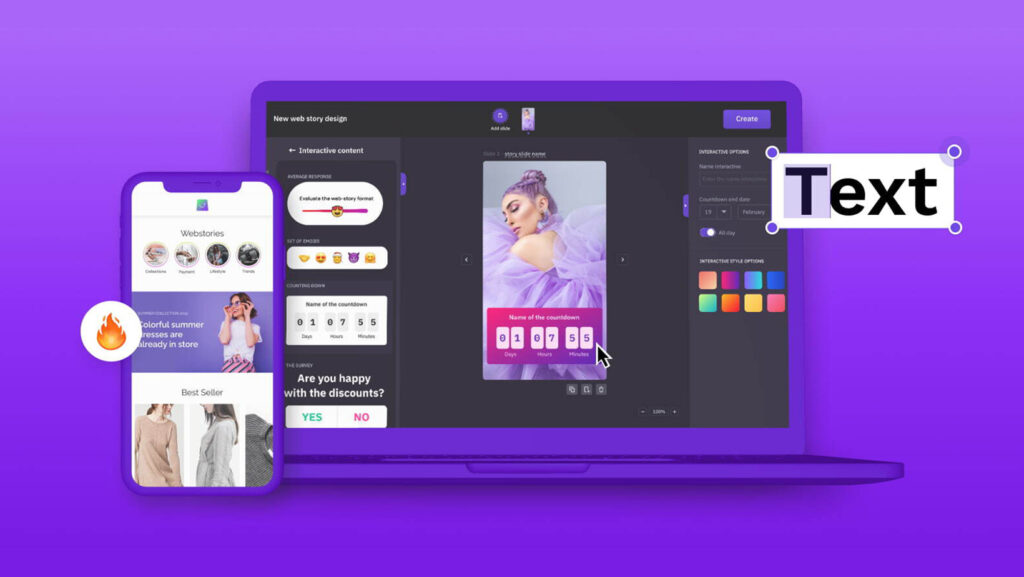Back in October 2013, Snapchat introduced a revolutionary concept of sharing photos and videos called Stories. Once it became popular, other platforms such as Instagram, Facebook and eventually Google followed suit by launching their version of stories. Today anyone can create Google web stories with minimal effort to easily promote their brand. The thing about web stories is that they aren’t limited to just social platforms anymore.
They are available on the web, meaning they can be crawled by search engines and you can share and link them just like a normal web page. So, if you want to learn how to make Google web stories, it’s pretty easy. In this step-by-step tutorial, we explain what these tools are and how to create Google web stories in WordPress.

Web Stories: A Brief Introduction
As the name implies, this is a web-based version of the stories format introduced by Google. They are primarily used for showing full-screen tappable content on the web. The format normally includes videos, images, text, etc. that offer visitors interactive experiences. As individuals initially used stories for sharing moments, brands soon understood their potential and started embracing them for their branding needs.
The biggest highlight of web stories is that they don’t disappear after 24 hours, and can be embedded in your webpage. They can also be kept for as long as possible. As they are not limited to photos and videos, they can be personalized to your requirements and used to increase page views, purposes, and maximise user engagement and visiting time, you can also monetize web stories.
How to make Google web stories
Now that you know what this is, let’s learn how to publish Google web stories with our step-by-step tutorial. These involve five steps which are explained below. One of the main features of web stories is that they can be built for both WordPress & non-WordPress websites. If you are a publisher using WordPress you can choose the official Google web stories plugin right here. If your website is a different one, you can still create web stories for non-wordpress site, let’s get started.
Step 1: Start with a visual editor
Before you get started, it is important to choose a web story builder that suits your requirements well. This is where you add your photos, videos, graphics, etc and do all the necessary customizations. The good thing is that there are a ton of tools to get started. Web Stories for WordPress, MakeStories and Newsroom AI are just a few visual editor examples. Also, you don’t need to be an expert in coding to design as there are a ton of Google web stories templates built-in which can be leveraged to make beautiful and engaging content.
Step 2: Prepare The Initial Draft
Before you create Google web stories, there must be a well-detailed plan. The most engaging web stories will have a compelling narrative of visuals and striking content that hooks the users and keeps them in place. Adding elements such as quizzes and polls helps increase engagement and interaction. Just like publishing stories on other social media platforms, all pages are published at once in web stories. If you are having any trouble, you can always reach out to the best WordPress website developers in Dubai for a helping hand.
Step 3: Implement the best visuals
Once you choose the right web story builder tool and draft a compelling narrative, the next part is to choose the visuals that complement your story. Searching for visuals isn’t that hard, however, getting the right visuals is the time-consuming part. Also, the visuals you choose must be formatted vertically to ensure the Google web stories size and will load quickly and use less bandwidth.
Step 4: Create & Publish Your Web Story
The answer to your question, “how to make Google web stories”, ends here. After brainstorming for ideas and visuals, finally you managed to compile all your text and visual assets. It’s time to start building your dream web story and publishing it. Choosing from the default list of templates offered by the web story builder is generally the most preferred and fastest way to make stories.
This involves dragging and dropping your chosen visuals into the tool, and adding a CTA to motivate your audience. The moment you feel everything’s perfect and going as planned, it’s time to share it with your audience by just clicking the publish button.
Implementing Web Stories on Your Website
Once you learn how to publish Google web stories, you can embed them on your website, Google images, and even on search. Embedding them on your site has its share of perks which are explained below.
Increased Brand Awareness
If you want to showcase your brand’s portfolio or creativity uniquely, making web stories using the right web story builder is the answer. Publishing one and embedding it on your site helps build a strong brand identity that is something your customers can’t miss out on for sure. Also, web stories are highly shareable.
This means customers can help spread your content across social media resulting in faster reach and brand recognition. With the right blend of appealing visuals and eye-catching content, increasing brand awareness is easier than ever.
Higher user engagement
Unlike social media posts or videos, web stories are primarily designed to be highly interactive and visually appealing on the first impression. The combination of rich visuals such as images, videos combined with compelling copy makes it a treat to engage with it for your audience.
Target New audiences
Want to target and capture the attention of the newer audience with a fresh and exciting concept? Get started and create Google web stories. The easiness of building one and the unlimited possibilities presented is definitely worth the time and cost involved.
Optimized for mobile
If you didn’t know, web stories are optimized for mobile devices. With the number of mobile internet users increasing, it only makes sense to embrace web stories for your brand growth, easier accessibility and faster reach to your audience.
Winding up
Web Stories can be considered a new channel for generating website traffic both organic and paid. Offering a set of tools that can be leveraged to make something exciting and unique, it also presents an opportunity to obtain a stable source of traffic that your competitors may not be aware of. If you still prefer to learn how to make google web stories, the professionals at GTECH can help you with that aspect.
Related Post
Publications, Insights & News from GTECH







